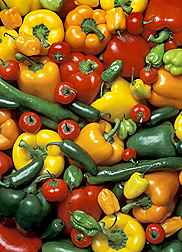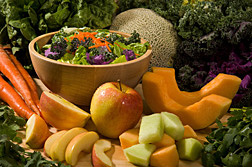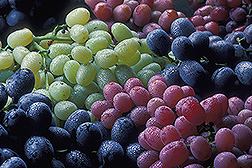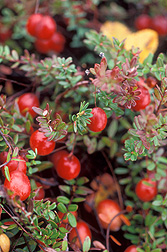| July 2016 |
Cranberry Compound May Help Prevent Urinary Tract InfectionsA new cranberry bioactive component that has the potential to control urinary tract infections (UTIs) has been identified by Agricultural Research Service (ARS) scientists and their collaborators. The bioactive component, referred to as SSGG fraction, is found in cranberry juice and is purified from enzyme-treated cranberry pulp. In laboratory tests, SSGG was found to inhibit Escherichia coli—the most common bacterial cause of UTIs—from sticking to human cells. ARS and Ocean Spray representatives have a recently approved patent describing how to produce cranberry xyloglucan oligosaccharides that have anti-adhesive activity. For details, contact: Arland Hotchkiss, (215) 233-6448, Dairy and Functional Foods Unit, Eastern Regional Research Center, Wyndmoor, Pennsylvania. |
|
Native Vine's Sap Eyed as Potential Gum Arabic AlternativeAgricultural Research Service (ARS) researchers have found a sap oozing from the stem of frost grapes, a native U.S. grapevine, that has an uncanny similarity to gum Arabic, a common thickening agent and emulsifier used in cake frosting, candies, paints, cosmetics and other products. Gum Arabic is harvested commercially from wild acacia trees throughout the Sahara region of Africa, with more than 80 percent of commercial production centered in Sudan. Domestic equivalents of gum Arabic have proven elusive—until possibly now. Frost grape, Vitis riparia, occurs throughout North America and typically grows as a woodland vine reaching up to 50 feet in length and measuring four to five inches in diameter. Nuclear magnetic resonance spectroscopy found frost grape sap to be a "polysaccharide," a type of long-chain carbohydrate whose ratio of two primary sugars resembles that of gum Arabic. For details, contact: Neil Price, (309) 681-6246, Renewable Product Technology Research Unit, National Center for Agricultural Utilization Research, Peoria, Illinois. |
|
New Hope for Extending Fresh-cut Vegetable StorageAn Agricultural Research Service (ARS) team evaluated a diverse collection of peppers for attributes that would prolong their shelf life after being cut. They looked at 50 types of peppers available commercially and from the ARS germplasm collection—sweet bell, large elongated peppers, jalapeño and serrano—to find those that can stand up to prolonged cold storage. Fresh-cut sweet bell and elongated peppers exhibited signs of deterioration, such as fluid leakage, after 10 to 14 days of storage, whereas jalapeño and serrano peppers didn't lose fluids until after 14 days of storage. Fluid leakage is undesirable as it causes peppers to lose firmness and marketability. Some varieties in each pepper type showed exceptional fluid maintenance beyond 14 days, meaning the peppers stayed firm and didn't exhibit tissue breakdown. The results provide opportunities for plant breeders, via traditional breeding, to incorporate attributes that contribute to fresh-cut quality into elite varieties that will benefit the food industry and consumers. For details, contact: John Stommel, (301) 504-5583, Genetic Improvement of Fruits and Vegetables Laboratory, Beltsville Agricultural Research Center, Beltsville, Maryland. |
|
The Not-So-Sweet Truth About SugarsA study conducted by Agricultural Research Service (ARS) scientists indicates that consuming lower amounts of added sugars is a more effective approach to health than consuming a sugar that is more neutral in terms of its health effects. This study was part of an effort to solve the controversy over whether all sweeteners produce the same metabolic effects in consumers despite the sweeteners' chemical similarities. The researchers looked at whether there was a difference in the metabolic and health effects of chronically consuming sugar, high fructose corn syrup (HFCS), or honey. Volunteers in the study did not show any differences in blood sugar levels based on the dietary sugar source. In addition, blood triglyceride levels, an indicator of blood fat concentrations (a marker for heart disease risk), increased in response to all three sugars tested. For details, contact: Susan Raatz, (701) 795-8274, Grand Forks Human Nutrition Research Center, Grand Forks, North Dakota |
|
Antimicrobial Wash Reduces Health Risks in Fresh ProduceAn antimicrobial wash that reduces the risk of foodborne pathogens in fresh produce has been developed by an Agricultural Research Service (ARS) scientist and his collaborators. The combination of lactic acid, fruit acids and hydrogen peroxide can be used in a produce rinse for commercial food distributors. First Step+ 10, the new product, is expected to be used in the commercial flumes and rinse tanks that wash fresh produce. The wash also has been approved for use in Canada; is U.S. Department of Agriculture (USDA) certified organic; biodegradable; and does not affect the taste, texture, smell, or appearance of produce. To test First Step+ 10, fresh-cut apples, baby spinach, cantaloupe rind, and cherry tomatoes were inoculated with highly resistant strains of E. coli O157:H7, Listeria and Salmonella. The antimicrobial wash reduced pathogen levels on the produce by 99.99 percent. It also rid the wash water of 100 percent of pathogens, making it safer to reuse on other produce. For details, contact: Joshua Gurtler, (215) 233-6788, Food Safety and Intervention Technologies Unit, Eastern Regional Research Center, Wyndmoor, Pennsylvania. |
|
Lowering the Risk of Infection with GrapesEating grapes may help obese people decrease certain types of fats in their blood that are linked to heart disease and lower their risk of infection, according to an Agricultural Research Service (ARS) study. Obese participants in the study drank either a mixture of water and grape powder made from freeze-dried table grapes or a placebo twice a day for three weeks. The two groups switched to the opposite mixture for the next three weeks. When scientists stimulated immune cells from blood with a bacterial component, they found an increase in the production of proteins—cytokines—that are instrumental in fighting off infections. For details, contact: Susan Zunino, (530) 752-5156, Immunity and Disease Prevention Research Unit, University of California, Davis, California. |
|
Sodium Monitoring Key to Reducing Dietary IntakesOver 90 percent of the U.S. population consumes more than the recommended daily maximum amount of sodium, most of which comes from commercially processed and restaurant foods. Reducing sodium in these foods is key to lowering the amount in the U.S. diet. Agricultural Research Service (ARS) scientists and their collaborators have now launched an online dataset of key foods that contain sodium added during preparation or processing prior to purchase by consumers. They have been working on the project to monitor key high-sodium foods since 2010 to serve as indicators for assessing changes over time in the sodium content of common sodium-contributing commercial foods. The dataset is available on the Nutrient Data Laboratory (NDL) home page and may be found at /Services/docs.htm?docid=22861 Details For details, contact: Jaspreet Ahuja, (301) 504-0695, Nutrient Data Laboratory, Beltsville Human Nutrition Research Center, Beltsville, Maryland. |
|
Walnuts Lower in Calories than Label SuggestsAgricultural Research Service (ARS) scientists have found that walnuts have fewer calories than previously thought. Using current techniques, they found that a typical 28-gram serving actually contains 146 calories, 21 percent fewer than the 185 calories currently assigned by the U.S. Department of Agriculture (USDA). The current system for calculating calories generally works well for estimating calories in mixed diets involving several foods, but not so well for estimating calories in certain foods individually, including tree nuts. In the 1950s, scientists grouped walnuts and other tree nuts with other plant-based foods, such as dry beans, legumes and peas, and estimated the calories of energy those foods contained in each gram of protein, carbohydrate and fat. For details, contact: David J. Baer, (301) 504-8719, Food Components and Health Laboratory, Beltsville Human Nutrition Research Center, Beltsville, Maryland. |
|
Ancient Grains Make Healthful, Tasty CookiesNew chia-oat and amaranth-oat mixtures developed by Agricultural Research Service (ARS) scientists may be used to make healthful foods in the future. Scientists at the National Center for Agricultural Utilization Research in Peoria, Illinois, examined the physical properties of chia and amaranth that contain lysine—an essential amino acid. They also experimented with blending amaranth flour with oat products containing beta-glucan, which is associated with lowering blood cholesterol, to make nutritious, gluten-free sugar cookies. They demonstrated that amaranth-oat and chia-oat composites have desirable physical qualities such as improved texture. These qualities, along with the ancient grains' nutritional value, may make them desirable ingredients for healthful foods. For details, contact: George E. Inglett, (309) 681-6363, Functional Foods Research Unit, National Center for Agricultural Utilization Research, Peoria, Illinois. |
|
Cranberry Juice Can Boost Heart HealthDrinking two glasses of cranberry juice a day can lead to significant heart health benefits, according to a study led by an Agricultural Research Service (ARS) physiologist. After 8 weeks, volunteers given the juice had lower levels of 5 of 22 indicators of cardiometabolic risk in their blood, compared with volunteers given a placebo, "a notable result." Cardiometabolic risk is the combined risk of cardiovascular disease (CVD), diabetes and stroke, which together causes more deaths in the developed world than anything else. CVD alone causes about 930,000 deaths in the United States each year. For details, contact: Janet Novotny, (301) 504-8263, Food Components and Health Laboratory, Beltsville Human Nutrition Research Center in Beltsville, Maryland. |
|
Roberts Delivers 2016 ARS W.O. Atwater Memorial Lecture at Experimental Biology"How Can Nutrition Scientists Help Reverse the Obesity Epidemic?" was the subject of Susan B. Roberts' 2016 W.O. Atwater Memorial Lecture, which she gave at the Experimental Biology meeting in San Diego in April. Roberts is internationally recognized as an expert in nutrition and a visionary when it comes to scientifically developing and testing new methods for dealing with obesity and weight control research. The Agricultural Research Service (ARS) established the W.O. Atwater Memorial Lecture in 1968 to honor the memory of Wilbur Olin Atwater (1844-1907) and to recognize scientists who have made unique contributions toward improving the diet and nutrition of people around the world. For details, contact: Kim Kaplan, (301) 504-1637, ARS Office of Communications, Beltsville, Maryland. |
|
New Wheat Line Eliminates Discoloring in FoodsGetting rid of gray discoloring in foods such as fresh noodles, breads and refrigerated biscuits is now possible, thanks to a new white hard wheat breeding line developed by Agricultural Research Service (ARS) scientists. They have developed a wheat that has no polyphenol oxidase—an enzyme present in all plants that causes discoloring. The enzyme causes browning in sliced apples, black spots in cut avocados and dark marks on banana peels. The new wheat line, 070R1074, was developed by crossing two Australian wheats entered into the ARS National Small Grains Collection in the 1930s. Collaborating with the University of Nebraska and Montana State University, Graybosch screened wheats in the Collection for polyphenol oxidase and then mated wheats with different forms of the genes that produced this enzyme. Naturally occurring genetic mutations in the new wheat line resulted in a nearly complete loss of polyphenol oxidase activity. Researchers have used the trait to improve breeding lines and could eventually incorporate it into elite lines to produce highly desirable cultivars. For details, contact: Robert Graybosch, (402) 472-1563, Grain, Forage, and Bioenergy Research Laboratory, Lincoln, Nebraska. |













